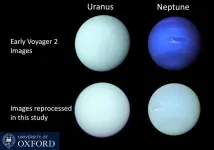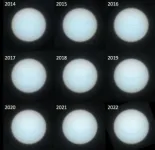(Press-News.org) Under embargo until 00:01 GMT on Friday 5 January 2024 /19:01 ET Thursday 4 January 2024
Royal Astronomical Society and University of Oxford press release
Neptune is fondly known for being a rich blue and Uranus green – but a new study has revealed that the two ice giants are actually far closer in colour than typically thought.
The correct shades of the planets have been confirmed with the help of research led by Professor Patrick Irwin from the University of Oxford, which has been published today in the Monthly Notices of the Royal Astronomical Society.
He and his team found that both worlds are in fact a similar shade of greenish blue, despite the commonly-held belief that Neptune is a deep azure and Uranus has a pale cyan appearance.
Astronomers have long known that most modern images of the two planets do not accurately reflect their true colours.
The misconception arose because images captured of both planets during the 20th century – including by NASA’s Voyager 2 mission, the only spacecraft to fly past these worlds – recorded images in separate colours.
The single-colour images were later recombined to create composite colour images, which were not always accurately balanced to achieve a “true” colour image, and – particularly in the case of Neptune – were often made “too blue”.
In addition, the early Neptune images from Voyager 2 were strongly contrast enhanced to better reveal the clouds, bands, and winds that shape our modern perspective of Neptune.
Professor Irwin said: “Although the familiar Voyager 2 images of Uranus were published in a form closer to ‘true’ colour, those of Neptune were, in fact, stretched and enhanced, and therefore made artificially too blue.”
“Even though the artificially-saturated colour was known at the time amongst planetary scientists – and the images were released with captions explaining it – that distinction had become lost over time.”
“Applying our model to the original data, we have been able to reconstitute the most accurate representation yet of the colour of both Neptune and Uranus.”
In the new study, the researchers used data from Hubble Space Telescope’s Space Telescope Imaging Spectrograph (STIS) and the Multi Unit Spectroscopic Explorer (MUSE) on the European Southern Observatory’s Very Large Telescope. In both instruments, each pixel is a continuous spectrum of colours.
This means that STIS and MUSE observations can be unambiguously processed to determine the true apparent colour of Uranus and Neptune.
The researchers used these data to re-balance the composite colour images recorded by the Voyager 2 camera, and also by the Hubble Space Telescope’s Wide Field Camera 3 (WFC3).
This revealed that Uranus and Neptune are actually a rather similar shade of greenish blue. The main difference is that Neptune has a slight hint of additional blue, which the model reveals to be due to a thinner haze layer on that planet.
The study also provides an answer to the long-standing mystery of why Uranus’s colour changes slightly during its 84-year orbit of the Sun.
The authors came to their conclusion after first comparing images of the ice giant to measurements of its brightness, which were recorded by the Lowell Observatory in Arizona from 1950 – 2016 at blue and green wavelengths.
These measurements showed that Uranus appears a little greener at its solstices (i.e. summer and winter), when one of the planet’s poles is pointed towards our star. But during its equinoxes – when the Sun is over the equator – it has a somewhat bluer tinge.
Part of the reason for this was known to be because Uranus has a highly unusual spin.
It effectively spins almost on its side during its orbit, meaning that during the planet’s solstices either its north or south pole points almost directly towards the Sun and Earth.
This is important, the authors said, because any changes to the reflectivity of the polar regions would therefore have a big impact on Uranus’s overall brightness when viewed from our planet.
What astronomers were less clear about is how or why this reflectivity differs.
This led the researchers to develop a model which compared the spectra of Uranus’s polar regions to its equatorial regions.
It found that the polar regions are more reflective at green and red wavelengths than at blue wavelengths, partly because methane, which is red absorbing, is about half as abundant near the poles than the equator.
However, this wasn’t enough to fully explain the colour change so the researchers added a new variable to the model in the form of a ‘hood’ of gradually thickening icy haze which has previously been observed over the summer, sunlit pole as the planet moves from equinox to solstice.
Astronomers think this is likely to be made up of methane ice particles.
When simulated in the model, the ice particles further increased the reflection at green and red wavelengths at the poles, offering an explanation as to why Uranus is greener at the solstice.
Professor Irwin said: “This is the first study to match a quantitative model to imaging data to explain why the colour of Uranus changes during its orbit.”
“In this way, we have demonstrated that Uranus is greener at the solstice due to the polar regions having reduced methane abundance but also an increased thickness of brightly scattering methane ice particles.”
Dr Heidi Hammel, of the Association of Universities for Research in Astronomy (AURA), who has spent decades studying Neptune and Uranus but was not involved in the study, said: “The misperception of Neptune’s colour, as well as the unusual colour changes of Uranus, have bedevilled us for decades. This comprehensive study should finally put both issues to rest.”
The ice giants Uranus and Neptune remain a tantalising destination for future robotic explorers, building on the legacy of Voyager in the 1980s.
Professor Leigh Fletcher, a planetary scientist from the University of Leicester and co-author of the new study, said: “A mission to explore the Uranian system – from its bizarre seasonal atmosphere, to its diverse collection of rings and moons - is a high priority for the space agencies in the decades to come.”
However, even a long-lived planetary explorer, in orbit around Uranus, would only capture a short snapshot of a Uranian year.
“Earth-based studies like this, showing how Uranus’ appearance and colour has changed over the decades in response to the weirdest seasons in the Solar System, will be vital in placing the discoveries of this future mission into their broader context,” Professor Fletcher added.
Media contacts
Robert Massey
Royal Astronomical Society
Mob: +44 (0)7802 877699
press@ras.ac.uk
Sam Tonkin
Royal Astronomical Society
Mob: +44 (0)7802 877700
press@ras.ac.uk
Dr Caroline Wood
Communications Manager (Research and Innovation)
University of Oxford
Tel: (+44) 01865 280534
caroline.wood@admin.ox.ac.uk
Science contacts
Professor Patrick Irwin, University of Oxford
patrick.irwin@physics.ox.ac.uk
Tel: +44 (0)1865 272083
Mob: +44 (0) 7960752607
Professor Leigh Fletcher, University of Leicester
LNF2@leicester.ac.uk
Tel: +44 (0)116 252 3585
Mob: +44 (0) 771995443
Images, videos and captions
Available at: https://drive.google.com/drive/folders/1WZfNh6SJvmTvC7Qlgz2VFWeC4W8xMKEz
Images/video can be used in articles for editorial purposes if credited. These cannot be distributed to third parties.
Further information
The new study “Modelling the seasonal cycle of Uranus’s colour and magnitude, and comparison with Neptune”, Patrick G.J. Irwin et al., will be published in Monthly Notices of the Royal Astronomical Society on 5 January 2024 at 00:01 GMT at https://academic.oup.com/mnras/article-lookup/doi/10.1093/mnras/stad3761
The link will go live when the embargo lifts. To view a copy of the study before this, contact press@ras.ac.uk
Notes for editors
About the Royal Astronomical Society
The Royal Astronomical Society (RAS), founded in 1820, encourages and promotes the study of astronomy, solar-system science, geophysics and closely related branches of science. The RAS organises scientific meetings, publishes international research and review journals, recognises outstanding achievements by the award of medals and prizes, maintains an extensive library, supports education through grants and outreach activities and represents UK astronomy nationally and internationally. Its more than 4,000 members (Fellows), a third based overseas, include scientific researchers in universities, observatories and laboratories as well as historians of astronomy and others.
The RAS accepts papers for its journals based on the principle of peer review, in which fellow experts on the editorial boards accept the paper as worth considering. The Society issues press releases based on a similar principle, but the organisations and scientists concerned have overall responsibility for their content.
Keep up with the RAS on X, Facebook, Instagram, LinkedIn and YouTube.
About the University of Oxford
Oxford University has been placed number 1 in the Times Higher Education World University Rankings for the eighth year running, and number 3 in the QS World Rankings 2024. At the heart of this success are the twin-pillars of our ground-breaking research and innovation and our distinctive educational offer.
Oxford is world-famous for research and teaching excellence and home to some of the most talented people from across the globe. Our work helps the lives of millions, solving real-world problems through a huge network of partnerships and collaborations. The breadth and interdisciplinary nature of our research alongside our personalised approach to teaching sparks imaginative and inventive insights and solutions.
Through its research commercialisation arm, Oxford University Innovation, Oxford is the highest university patent filer in the UK and is ranked first in the UK for university spinouts, having created more than 300 new companies since 1988. Over a third of these companies have been created in the past five years. The university is a catalyst for prosperity in Oxfordshire and the United Kingdom, contributing £15.7 billion to the UK economy in 2018/19, and supports more than 28,000 full time jobs.
END
New images reveal what Neptune and Uranus really look like
2024-01-05
ELSE PRESS RELEASES FROM THIS DATE:
Students build science identity through immersive research experience
2024-01-05
Each summer, community college students from Colorado and surrounding states converge on the CU Boulder campus to participate in an immersive nine-week research program. A recent CIRES-led study reveals that when the students head home, they don’t just take new scientific and professional skills with them—they also leave with more confidence in their ability to do science and a greater sense of belonging in the science community. The work, published last month in PLOS ONE, suggests that authentic research experiences inspire community college students’ interest in STEM careers.
“Paid, ...
Bipolar disorder linked to early death more than smoking
2024-01-04
Having bipolar disorder – a serious mental illness that can cause both manic and depressed moods – can make life more challenging.
It also comes with a higher risk of dying early. Now, a study puts into perspective just how large that risk is, and how it compares with other factors that can shorten life.
In two different groups, people with bipolar disorder were four to six times more likely as people without the condition to die prematurely, the study finds.
By contrast, people who had ever smoked were about twice as likely to die prematurely than those ...
Most babies with sickle cell disease face double disadvantage
2024-01-04
As if starting life with a potentially disabling genetic blood disease wasn’t enough, a study shows that almost two-thirds of babies born with sickle cell disease are born to mothers who live in disadvantaged areas.
But the study shows wide variation between states in the rate of births of babies with sickle cell to residents of areas with crowded housing, limited transportation options and other characteristics.
The researchers say their data could help public health authorities focus efforts to support the complex needs of children with sickle cell disease and their families.
The ...
Study shows liraglutide results in increased insulin sensitivity independent of weight loss
2024-01-04
A new study published in the journal Diabetes demonstrates that a glucagon-like peptide-1 receptor (GLP-1R) agonist, a member of a class of medication used to treat Type 2 diabetes and obesity, can lead to a rapid improvement in insulin sensitivity.
Insulin sensitivity is how responsive cells are to insulin, an essential hormone that controls blood glucose levels. An increase in insulin sensitivity means insulin can more effectively lower the blood glucose. Reduced insulin sensitivity or insulin resistance is a feature of Type 2 diabetes. Thus, improved ...
YAP and TAZ: Protein partners identified as potential key for fetal bone development
2024-01-04
A pair of proteins, YAP and TAZ, has been identified as conductors of bone development in the womb and could provide insight into genetic diseases such as osteogenesis imperfecta, known commonly as “brittle bone disease.” This small animal-based research, published today in Developmental Cell and led by members of the McKay Orthopaedic Research Laboratory of the Perelman School of Medicine at the University of Pennsylvania, adds understanding to the field of mechanobiology, which studies how mechanical forces influence biology.
“Despite more than a century of study on the mechanobiology of bone development, the cellular and molecular ...
Skin-deep resilience: Hidden physical health costs for minority youth overcoming adversity
2024-01-04
Urbana, Ill. – When youth thrive despite difficult circumstances, they are usually lauded for their accomplishments. However, overcoming adversity may have a hidden physiological cost, especially for minority youth. A new study from the University of Illinois Urbana-Champaign looks at physiological changes among high-striving minority youth in early adolescence.
“In the past decade, researchers have observed a phenomenon termed ‘skin-deep resilience.’ Historically, youth from disadvantaged backgrounds who ‘beat the odds’ were assumed to have universally positive outcomes. They are achieving academically, avoiding problematic behaviors, and scoring well on ...
Early nerve intervention reduces pain and complications after amputation
2024-01-04
Waltham — January 4, 2024 — Performed early – at the time of amputation – a procedure called targeted muscle reinnervation (TMR) can reduce pain scores and prevent complications related to abnormal nerve regrowth, suggests a study in the January issue of Plastic and Reconstructive Surgery®, the official medical journal of the American Society of Plastic Surgeons (ASPS). The journal is published in the Lippincott portfolio by Wolters Kluwer.
"Our experience suggests that that acute TMR reduces neuroma formation, and lowers the incidence of both phantom ...
Seizures identified as potential cause of sudden unexplained death in children
2024-01-04
In a study designed to better understand sudden, unexpected deaths in young children, which usually occur during sleep, researchers have identified brief seizures, accompanied by muscle convulsions, as a potential cause.
Experts estimate in excess of 3,000 families each year in the United States lose a baby or young child unexpectedly and without explanation. Most are infants in what is referred to as sudden infant death syndrome, or SIDS, but 400 or more cases involve children aged 1 and older, and in what is called sudden unexplained death in children (SUDC). Over half of these children are toddlers.
The study findings come from a registry of more than 300 SUDC cases, set up ...
Where’s the snow? Northeastern cities see record temps, low snowfall in 2023
2024-01-04
CORNELL UNIVERSITY MEDIA RELATIONS OFFICE
FOR RELEASE: Jan. 4, 2024
Kaitlyn Serrao
607-882-1140
kms465@cornell.edu
Where’s the snow? Northeastern cities see record temps, low snowfall in 2023
ITHACA, N.Y. - In the Northeastern United States, warming average temperatures for most all climate data sites in December 2023 ranged from 3.6 to 9 degrees Fahrenheit above normal – making 2023 the warmest year on record for 13 of the region’s 35 major locations, including New York City.
A total of 28 cities in the region saw one of their top-five warmest years, according to a report Jan. 2 ...
World's largest physics conference to be held in Minneapolis and online this March
2024-01-04
More than 13,000 physicists from around the world will convene to present groundbreaking research at the American Physical Society’s (APS) March Meeting. The conference will be held in person in Minneapolis and online everywhere March 3-8.
Scientific Program
The scientific program includes nearly 900 sessions and 11,000 individual presentations on new research in climate science, medicine, biological physics, quantum information, superconductivity, condensed matter, and more. For more information, search the scientific program. All times are in Central time.
Hybrid Format
The March Meeting will have both in-person and online experiences. ...



